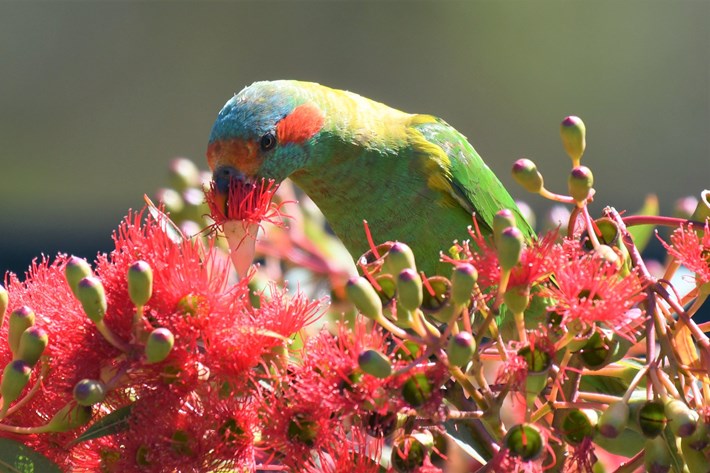A greener, cooler, more liveable City
What we’re doing
Below are the latest actions from the February 2022 Climate Action Update.
Investing in our assets
- Planting trees and vegetation in our streets and parks and increasing biodiverse and climate resilient species, including the Danks Street biodiversity corridor in Albert Park
- Trialling heat reducing materials in footpaths and laneways.
Working with our community and partners
- Developing an updated Greening Port Phillip Strategy and identifying new ways to improve greening outcomes
- Continuing to partner with and fund the EcoCentre to deliver community programs about biodiversity and volunteering initiatives to protect and restore native vegetation and habitats.
- Working with the Victorian Government to maximise the number of trees retained as part of the Metro Tunnel works and support their target to ‘double canopy cover by 2040’ around the new Anzac train station.
- Working with the Victorian Government, City of Melbourne developers and the community to create a biodiverse urban forest in Fishermans Bend including designing public spaces and buildings to increase vegetation and create habitat.
Changing how we deliver our services
- Trialling the Green Factor green infrastructure tool, in partnership with the City of Melbourne, to assess vegetation coverage through the planning process.
- Developing controls and guidance to protect and enhance trees and vegetation on private property
- Improving maintenance practices in our public spaces to protect and enhance native vegetation and habitat.
What we have done
Recent examples of how we are fostering a greener, cooler, more liveable City:
- Planted 41,337 plants through the Urban Forest Strategy 2021/22.
- We partnered with the University of Melbourne to trial Port Phillip's first woody meadow in Balaclava. This cost-effective way of managing complex open space plantings requires little maintenance or watering.
- Updated Nature Strip Guidelines and improved Community Gardening Program to increase greening in public areas.
- Drafted an update to the local law to increase the protection of large canopy trees.
- Completed a biodiversity study and have developed a set of actions for the Urban Forest Strategy and other strategies and projects.
- Adopted the Places for People: Public Space Strategy 2022-32, which sets the vision and blueprint for the future of our public spaces in the City of Port Phillip
- Invested in species diversification, park trees and streetscape improvements and prioritised biodiversity by planting indigenous and climate-tolerant species.
Canopy cover
A target has been set to increase canopy cover on streets and private land by 10 per cent. Increasing canopy cover has become even more critical in recent years, given the extra demand for green space following COVID-19 lockdowns due to more sports participation and more people working from home. We are also committed to identifying the best way to ensure we comply with requirements to keep tree branches away from electrical lines while preventing a large reduction in tree canopy.
Cooling South Melbourne Study
We worked with the University of New South Wales to map and model heat in South Melbourne to understand what could be done to reduce heat in the area and create a comfortable and liveable precinct for residents, workers and visitors.
On the ground research, future climate projections, and leading-edge scenario modelling has delivered cooling recommendations for South Melbourne that modelling indicates could deliver a cooler, more liveable precinct.
Identified as a heat hot spot due to land use, demographics and ambient temperature, Council wanted to gather suburb-specific heat data and model what could be done to reduce heat in the area and create a comfortable and liveable precinct for residents, workers and visitors.
The ‘Cooling South Melbourne’ study involved the use of aerial thermal mapping and on ground sensors to determine current heat profile. This data, along with a 3D model of the study area, enabled cooling intervention scenarios to be modelled. These intervention scenarios determined by Council and researchers, include increasing public and private urban greenery, changes to street, footpath and roof materials, water misting, and combinations of these.
The results show that all cooling intervention scenarios can effectively reduce street level air and surface temperature under current and future conditions.
Increasing urban greenery in the public realm and the addition of cool materials for all streets, footpaths and private hard surfaces was highly effective at reducing street level air and surface temperatures, especially in business and retail precincts that have wider, unshaded streets.
Moderate green infrastructure for private green coverage demonstrated an effective scenario for new buildings. While the impact of cool roofs is less than cool materials for hard urban surfaces, a green roof or reflective paint can also potentially improve indoor thermal comfort, reduce energy and air conditioning use and thereby reduce potential heating effects from the waste heat from air conditioning.
The most effective intervention scenario was the combination of all mitigation strategies including water misting sprays, which had a significant localised cooling impact on street level air and surface temperatures.
The analysis and recommendations regarding built form and public realm interventions provided through the study, will inform an updated South Melbourne Structure Plan (2007). Identified as a growth area, a key challenge for Council is to manage this future growth and redevelopment in South Melbourne in a way that does not limit its ability to mitigate and adapt to increasing heat. The findings from this study are not just South Melbourne specific, but are applicable across the whole of the City.
These nine scenarios and their cooling potential have also been integrated into the online and interactive Microclimate and Urban Heat Island Mitigation Decision- Support (UHI-DS) Tool.
Read the full study on Cooling South Melbourne (PDF 19 MB).

Photo taken through the EcoCentre NatureSpot program. Pictured: Musk lorikeet, Photo credit: Jo Samuel King